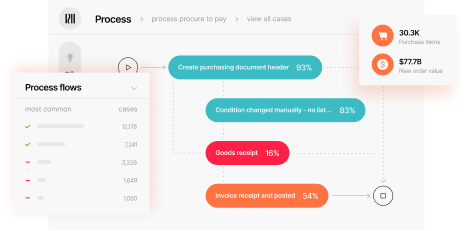How internal audit tools are transforming the future of work
Internal audit tools are transforming the internal audit function. AI-powered process discovery, integrity exposure detection, and integrity intelligence from Datricks help auditors eliminate financial exposures and align with IIA standards.


Quick navigation
FAQs
The internal audit profession has undergone significant changes in recent years due to technological innovation, regulatory requirements, and the ever-evolving business landscape. As organizations strive to become more agile, internal auditors must adapt and transform to remain relevant and add value to their organizations. The new Global Internal Audit Standards™ issued last year by the Institute of Internal Auditors (IIA) provides a roadmap for internal auditors to meet the demands of the future of work.
Changes introduced by the IIA
governance frameworks
to internal auditors
framework
and standards
Some notable changes introduced by the new standard include:
- Improving governance frameworks to strengthen organizations’ responsiveness to rapidly changing business environments
- Guidance regarding assistance to internal auditors in the public sector and for small internal audit functions
- A flexible framework that can adapt to the unique challenges faced by auditors in different parts of the world
- Specific input and standards on crucial areas like cybersecurity
The role of the CAE and internal audit tools
The standard also identifies Domain IV, which outlines the responsibilities of the Chief Audit Executive (CAE) in managing the internal audit function. This domain sets the foundation for long-range strategic planning for internal audit, something that was previously alluded to but not explicitly stated in previous standards.
Principle 9, “Strategically Plans,” covers key areas such as understanding governance, risk management, and control processes, internal audit strategy, the internal audit charter, methodologies, the internal audit plan, and coordination and reliance.
This principle provides a logical flow to managing resources, setting up methodologies, and communicating effectively with all stakeholders.
The standard also emphasizes effective communication as a critical aspect of the internal audit function, and Domain IV provides specific guidelines on what types of communications are necessary and how frequently they should occur.
Additionally, Domain IV provides a powerful means to clarify the internal auditor’s role and value to stakeholders, including senior management teams.

How the global internal audit standards streamline internal audit
The restructuring of the standards to bring together topics that were once dispersed across the six IPPF components demonstrates the IIA’s commitment to providing a comprehensive framework that internal auditors can follow.
This new standard not only guides CAEs but also provides internal auditors with a clear direction on how to manage their internal audit tools and other resources, build relationships, and ensure the performance of the function.
Internal audit and the future of work
Within its recommendations, the new standards put internal auditors’ future of work at the forefront and ask them specifically to embrace new technologies and internal audit tools, and to take a strategic approach.
The IIA’s new standard provides internal auditors with the guidance they need to navigate these changes and transform the internal audit function from box-checking to problem solvers achieving organizational objectives.
Internal auditors who embrace this new standard and the future of work will be well-positioned to add value to their organizations and remain relevant.
Ensuring Financial Integrity with internal audit tools
Within its recommendations, the new standards put internal auditors’ future of work at the forefront and ask them specifically to embrace new technologies and internal audit tools and to take a strategic approach.



Internal audit tools are no longer just about compliance; they must enable internal auditors to prevent, detect, and mitigate financial exposures such as human errors, non-compliance, and fraud. A Financial Integrity Platform provides the ultimate internal audit tool by offering:
- Autonomous process discovery: Continuously analyzing financial processes to uncover inefficiencies and compliance gaps.
- Integrity exposure detection: Using AI-driven analytics to surface anomalies and pinpoint vulnerabilities before they escalate.
- Integrity intelligence: Providing finance leaders with a real-time control tower to oversee financial health and focus audit efforts effectively.
How Datricks is the future of internal audit tools
Datricks is redefining the role of internal audit tools by aligning perfectly with the IIA’s vision for the future. As a Financial Integrity Platform, Datricks equips internal auditors with the capabilities they need to meet evolving standards and deliver unmatched financial oversight.
100% coverage
compliance efforts
audit efficiency
with minimal effort
Datricks enables internal auditors to:
- Ensure 100% coverage: Unlike traditional sampling methods, Datricks reviews all financial data in real time, ensuring no integrity exposure is missed.
- Streamline compliance efforts: Automated compliance tracking ensures all processes align with governance frameworks, reducing the manual burden on auditors.
- Enhance audit efficiency: With over 600+ pre-built detections and self-driving controls, internal auditors can reduce false positives and focus on high-impact exposures.
- Recover lost funds & prevent financial leakages: Datricks proactively identifies duplicate payments, unauthorized spending, and process bypasses to recover and protect financial assets.
- Deploy quickly with minimal effort: No lengthy implementations – Datricks integrates seamlessly with ERPs and internal systems, delivering value within seven days.
The future of work in internal audit
Internal auditors who embrace Datricks as an AI-powered internal audit tool will move beyond box-checking to becoming strategic partners in their organizations.
The IIA’s standards emphasize a forward-looking, technology-driven audit function, and Datricks embodies this shift by eliminating financial exposures and ensuring airtight financial integrity.
By leveraging Datricks, internal auditors can build trust, improve compliance, and drive peak performance: solidifying their role in shaping the future of financial oversight.